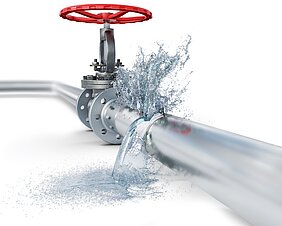Water supply companies have a strong interest in monitoring and minimising water losses in their pipe networks. To apply digital methods experts at TZW are developing algorithms and procedures for pattern recognition in order to analyse water consumption time series and to uncover special features. In this way, consumption anomalies and leakages in water distribution can be identified.
For many years, TZW has been working on the topics of digitalisation in the drinking water sector. One essential aspect is the analysis of large amounts of data with the aim of gaining new insights and thus creating added value for the water supply. Water consumption and the careful use of water are fundamental aspects of the proper operation of water supply. Innovative digital tools, which are being developed and tested at the TZW, are used to monitor and determine water losses.
Analysing operational key figures in detail
The starting point for the analysis is the water balance, which the company prepares annually and finds a significant difference between the amount of water billed and the amount distributed. This raises the question of how such a difference must be evaluated. DVGW Set of Rules W 392 provides assistance in this regard, listing various key figures (specific water loss, Infrastructure Leakage Index). Here, a differentiation is made between billed and unbilled water quantities. The difference between the network feed-in and feed-out forms the total water loss, which must be differentiated into a real and apparent loss.
The key figures mentioned are based on annual water balances. In order to be able to characterise the consumption more deeply, an analysis procedure was developed at TZW, which examines time series of feed-in or consumption data of a balance zone (closed supply area), which are available in a temporal resolution of less than one day (e.g. minute or hourly values). The aim of the data analysis is
- the determination of typical consumption patterns and
- the identification of anomalies, i.e. deviations from normal consumption behaviour.
The results of the analysis, especially the anomalies found, help to evaluate water losses. In this way, certain events can be precisely quantified. Apparent or real water losses can thus be analysed even more precisely.
Algorithms and pattern recognition as tools
Machine learning methods, in particular pattern recognition methods, form the basis of the procedure. The field of pattern recognition deals with the automatic discovery of regularities in data by using algorithms. Exactly these characteristics are needed for the analysis of consumption data. Typical consumption patterns are determined from time series data. Based on the normal behaviour, deviations are determined in a second analysis step, which are labelled as consumption anomalies. The TZW procedure differentiates between different types of anomalies, e.g. unusual minimum night-flow consumption or unusual individual withdrawals, which are quantified automatically.
The analysis procedure enables the evaluation of time-resolved time series of water consumption. It serves to identify both regularly occurring consumption patterns as well as anomalies that can be indications of water losses. The method can thus be a valuable support when it comes to evaluating water losses.

![[Translate to English:] Prüfstelle-Produktprüfung_Teststand Test centre and product testing](/fileadmin/_processed_/0/9/csm_TZW-Karlsruhe_Pruefung_Geraete-Teststand_377188946c.jpg)
























